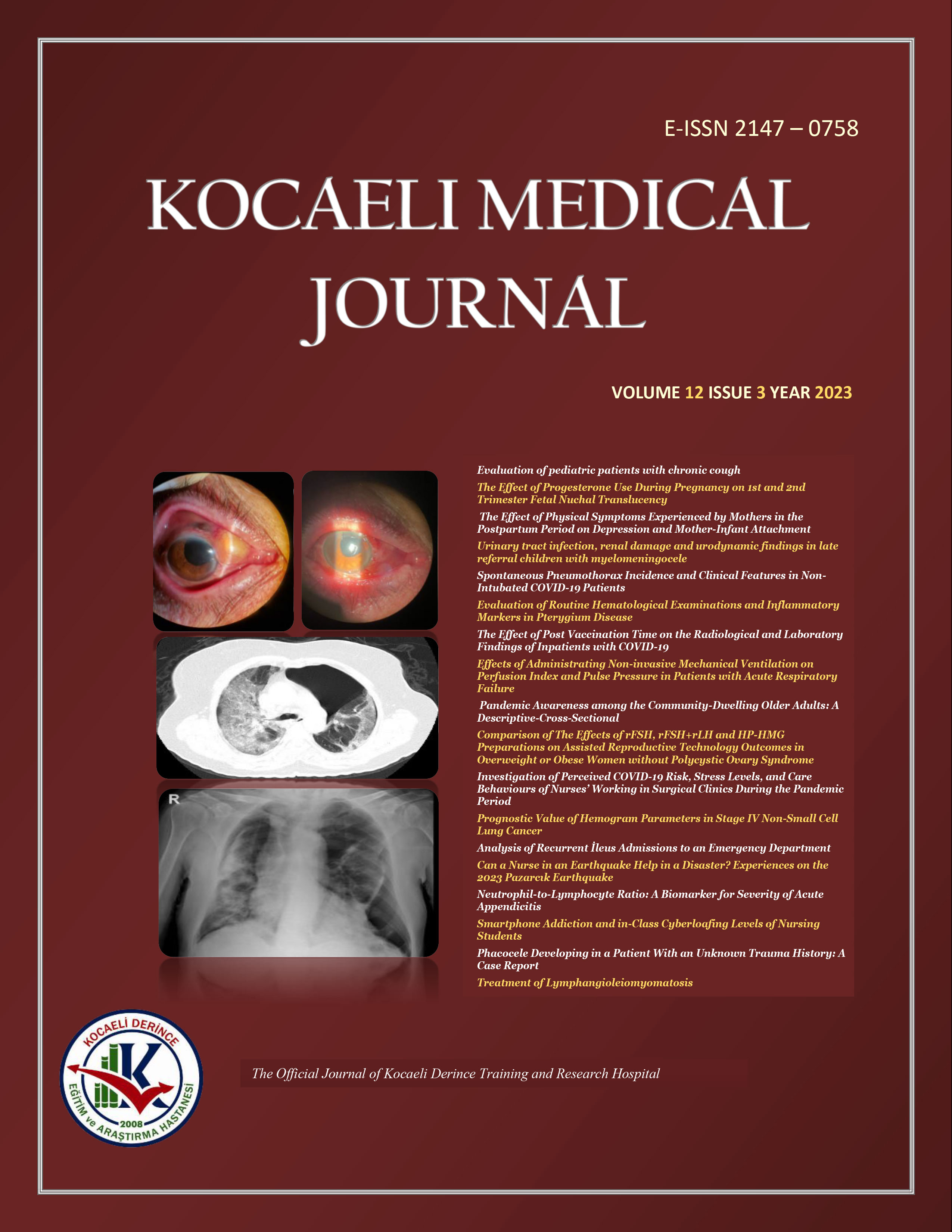
The Magnetic Resonance Findings of Soft Tissue Changes and Subluxation Accompanying to Shoulder Pain in Hemiplegic Patients
Rabia Terzi1, Neşe Ölmez2, Asuman Memiş21Kocaeli Derince Eğitim Ve Araştırma Hastanesi Fiziksel Tıp Ve Rehabilitasyon Kliniği2İzmir Atatürk Eğitim Ve Araştırma Hastanesi Fiziksel Tıp Ve Rehabilitasyon Kliniği
OBJECTIVE: Shoulder pain is a serious problem in hemiplegic patients with an incidence of 16-72%. It substantially affects the function of the upper extremity, worsens quality of life and may mask motor recovery. Therefore, the complications of the upper extremity should be well-known, and diagnosed and treated in the early stages in hemiplegic patients. Although shoulder pain is frequently encountered in hemiplegic patients, the etiology and treatment are still controversial.
METHODS: This study included 28 hemiplegic patients who had shoulder pain and 32 hemiplegic patients who did not have shoulder pain with hemiplegia within the previous six months. All patients underwent a detailed physical examination and demographic questioning, and demographic data, upper limb spasticity, motor stage of hemiplegia and passive range of motion were recorded. Radiographic subluxation was evaluated with the Van Langenberghe method based on vertical subluxation by using plain radiographs taken at the degree anterior oblique position, and soft tissue pathologies of the shoulder were evaluated with Magnetic Resonance Imaging.
RESULTS: In the group without shoulder, upper extremity and hand pain, Brunstroms stages were statistically higher than in the group with shoulder pain (p = 0.048). No statistically significant difference was found in upper limb spasticity and radiological subluxation between the two groups (P <0.05). Among Magnetic Resonance Imaging findings, the bursitis (p = 0.00), impingement of supraspinatus muscle (p = 0.009) and infraspinatus tendinitis (p = 0.026) were statistically significantly higher in the group with shoulder pain.
CONCLUSION: Our study showed that shoulder pain is more common and subluxation may be present without pain in patients with low motor recovery. Shoulder pain has many and various causes in hemiplegic patients. As reported in our study, it should be considered that bursitis, tendinitis and rotator cuff pathologies in particular are frequently seen in patients with hemiplegic shoulder pain. Magnetic Resonance Imaging can be used for detailed identification of soft tissue pathologies.
Hemiplejik Hastalarda Omuz Ağrısına Eşlik Eden Subluksasyon ve Yumuşak Doku Değişikliklerinin Magnetik Rezonans Görüntüleme Bulguları
Rabia Terzi1, Neşe Ölmez2, Asuman Memiş21Kocaeli Derince Eğitim Ve Araştırma Hastanesi Fiziksel Tıp Ve Rehabilitasyon Kliniği2İzmir Atatürk Eğitim Ve Araştırma Hastanesi Fiziksel Tıp Ve Rehabilitasyon Kliniği
AMAÇ: Omuz ağrısı hemiplejik hastalarda %16-72 oranında saptanan cidi bir problemdir. Üst ekstremite fonksiyonlarını ciddi şekilde etkiler, yaşam kalitesini kötüleştirir, motor fonksiyonların iyileşmesini maskeleyebilir. Bu nedenlerle hemiplejik hastalarda üst ekstremite komplikasyonlarının iyi bilinmesi ve erken dönemde tanı konulup tedavi edilmesi gerekmektedir. Hemiplejik hastalarda omuz ağrısına sıkça rastlandığı halde etiyoloji ve tedavisi konusunda tartışmalar sürmektedir.
YÖNTEMLER: Bu çalışma son 6 ay içinde hemipleji geçirmiş, omuz ağrısı tanımlayan 28 ve omuz ağrısı tanımlamayan 32 hemiplejik hasta üzerinde hastaların aydınlatılmış onamı alınarak yapılmıştır. Tüm hastaların ayrıntılı fizik muayeneleri ve demografik sorgulaması yapılarak, demografik verileri, üst ekstremitedeki spastisite, hemipleji motor evresi, pasif eklem hareket açıklığı kaydedildi. Radyolojik subluksasyon; kol desteklenmeden 45 derece anterior oblik pozisyonda çekilen direkt grafiler kullanılarak, vertikal subluksasyonu esas alan Van Langenberghe yöntemi ile, omuzdaki yumuşak doku patolojileri ise Magnetik Rezonans Görüntüleme ile değerlendirildi.
BULGULAR: Omuz ağrısı olmayan grupta üst ekstremite ve el brunstrom evrelemesi diğer gruba göre istatistiksel olarak daha yüksekti (p═0,048). Her iki grupta üst ekstremite spastisitesi ve radyolojik subluksasyon açısından istatistiksel olarak anlamlı bir fark yoktu (p>0.05). Magnetik Rezonans Görüntüleme bulgularından bursit (p=0.00), supraspinatus kasında impingemet (p=0,009), infraspinatus tendiniti omuz ağrılı grupta istatistiksel olarak anlamlı oranda yüksek bulunmuştur (p=0,026).
SONUÇ: Çalışmamızda motor fonksiyonlardaki iyileşmesi düşük olan hastalarda omuz ağrısının daha sık olduğu, subluksasyonun ağrıya eşlik etmeden de var olabileceği saptanmıştır. Hemiplejik hastalarda omuz ağrısının nedenleri çok çeşitlidir. Çalışmamızda da saptandığı gibi hemiplejik omuz ağrısında özellikle bursit, tendinit ve rotator cuf patolojilerinin sıklıkla görüldüğü göz önünde bulundurulmalıdır. Yumuşak doku patolojilerinin ayrıntılı olarak tespiti için Magnetik Rezonans Görüntülemeden yararlanılabilinir.
Corresponding Author: Rabia Terzi, Türkiye
Manuscript Language: Turkish












